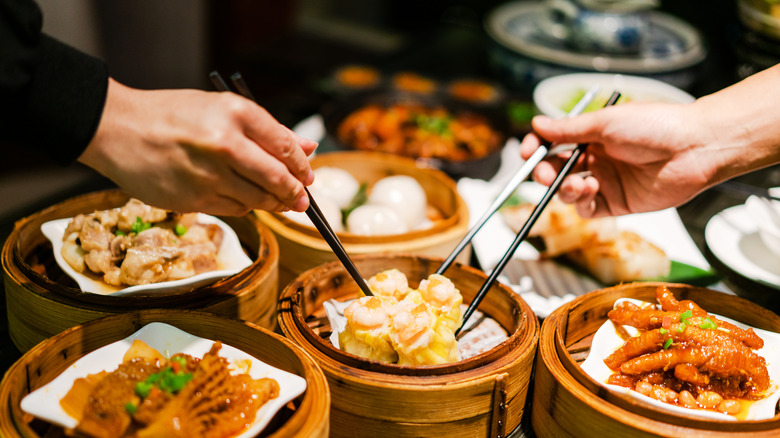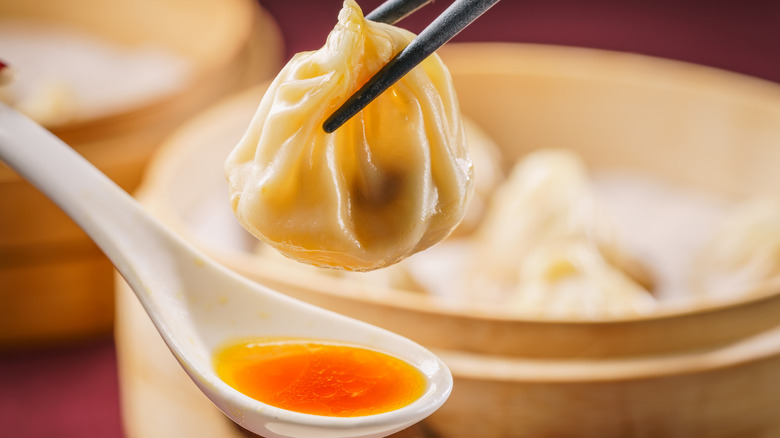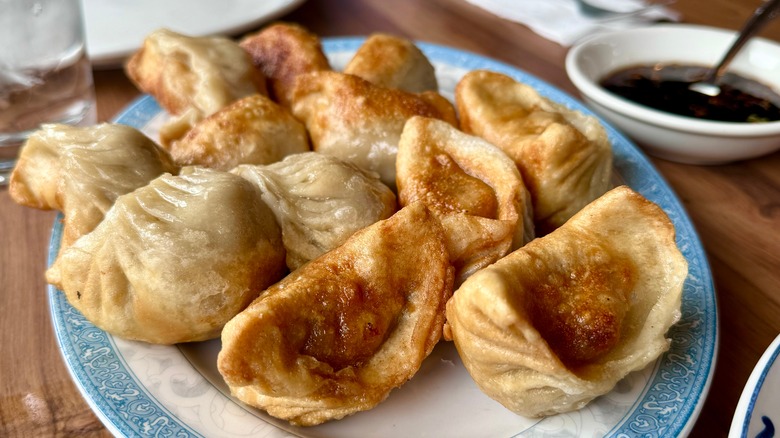Soup Dumplings Vs Potstickers: The Important Differences To Know
Almost every food culture around the world has a beloved dumpling or two, including Polish perogies, Middle Eastern samosas, and Japanese gyoza. Chinese cuisine, however, arguably contributes the most variety to the dumpling scene, boasting dozens of different varieties that are made with wheat, rice, or tapioca flour and can be cooked with steam, in hot oil, or via pan frying. So, it's forgivable if you're not entirely sure what the difference is between guo tie, which are also called potstickers, and xiaolongbao, a.k.a. soup dumplings.
Thankfully, there are some easy ways to tell the two apart. The most important and obvious difference is that soup dumplings actually contain liquid soup inside the dumpling itself. The second is that while both types of dumplings are steamed, potstickers are also cooked in a pan to give them a crispy, golden finish. As long as you know the basics between the two, you can be a little more confident navigating the menu next time you're out for dim sum.
Soup dumplings have soup inside
In China, specifically in Shanghai, soup dumplings are a serious business and point of pride. They're made with collagen-rich cuts of meat like pork that are mixed with spices and chunks of savory gelatin (also known as aspic). When the gelatin is cool, it'll have a jelly-like texture that can be easily mixed into ground meat for filling. The mixture is wrapped with dough while the filling is cool. When the dumplings are cooked, the aspic melts into a rich, flavorful soup that's trapped inside each little purse of dough.
Soup dumplings are steamed in bamboo baskets. When you order them at a restaurant, that's typically how they'll show up to your table. This is different from potstickers, which are cooked first in a steamer and then pan fried, so don't expect to see any browning on the outside of your soup dumplings. There's also an art to tackling these delicacies; a skilled xiaolongbao eater will bite a small hole in the bottom of the dumpling and suck out the hot soup before dunking the rest in sauce and gobbling it up. Be careful about burning your mouth with the hot broth; if things get too hot, try cooling down with a sip of cold Champagne between bites.
Potstickers are pan-fried
Soup dumplings have become popular in the U.S. in recent years, but potstickers are still a major go-to style for anyone with a dumpling craving. The biggest difference between the two is the filling — potstickers don't have any of the gelatin of a soup dumpling, thus no soup. They can use almost any kind of meat or vegetable fillings, and they're a little easier to make at home.
Potstickers tend to have thin outsides, and they're often made with fresh wonton-style wrappers as opposed to the thicker doughs used for soup dumplings. This gives them a little bit of an edge if you're trying to order items that aren't as starchy. They are also steamed just like soup dumplings, but they then take a trip through a hot pan with some oil before they're served and will have a crispy, brown exterior on one side. Since they're crispy on the outside, they won't be served in a steamer if you're out at a restaurant. You can even air fry frozen potstickers at home, which are pre-cooked before they're frozen so they don't need any steaming.
Can't decide between potstickers and soup dumplings? Go for both. Each style of dumpling is packed with flavor and both have their own charms — the more dumplings the merrier.



